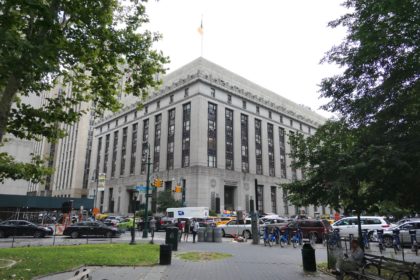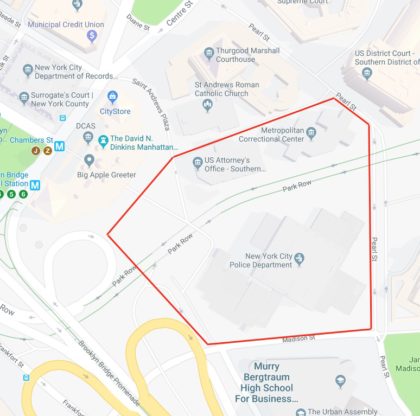The City Wants to Build a 40-Story Jail on Worth Street
 A report in the New York Daily News is likely to alarm residents of East Tribeca and Chinatown:
A report in the New York Daily News is likely to alarm residents of East Tribeca and Chinatown:
The de Blasio administration is eyeing 80 Centre St.—now home to the city’s marriage bureau—as the perfect location for a high-rise detention center as part of a sweeping plan to close Rikers Island. The plan was unveiled by mayoral aides at a hush-hush meeting with community leaders Thursday. The block-long building adjacent to Foley Square would be totally gutted, sources said. The historic nine-story art-deco structure would serve as a base for a much bigger building that could reach 40 stories, according to sources. […] The new jail may also include affordable housing apartments, according to community leaders who were briefed on the proposal. The 80 Centre St. building is a change-up from the city’s prior plan to expand its existing lower Manhattan jail, the Manhattan Detention Complex, also known as The Tombs. But jail officials have now determined the complex on 125 White St. is too small.
A few thoughts….
1. I didn’t follow the whole Rikers Island story closely, but I never understood how shutting down the facility could be expected to address the problems that stemmed from bad management. It’s not like the land was cursed. Is there any guarantee that starting over elsewhere would lead to a different conclusion?
2. Throwing in affordable housing seems like an easy way to get local politicians onboard, because no one wants to be seen as opposing it. But who wants to live above a jail? It’s fun to imagine the marketing campaign for the residences (it could be named The Pen, The Big House, or maybe The Slammer), but of course there’s no need to market subsidized housing.
3. Jamming a tower into the shell of a terrific old building destroys the integrity of the original. Show me an example of one that really works. Moreover, it’d stick out like a sore thumb in the stately Civic Center. As the the city’s own web page about the 1929 building says,“William Haugaard, state architect, designed 80 Centre Street under a height restriction so that it would not overshadow the nearby courthouses and symmetry of Foley Square.”
4. Instead of this idea, I wish someone with vision would lay out a plan for the entire area behind the Municipal Building: It’s a poorly designed mess, and a top-to-bottom rethink, including the NYPD headquarters and Park Row, could turn a neglected corner of Manhattan into something that actually works.












The replacement for Rikers Island should go on Staten Island.
Queens should definitely keep it or any jail.
I agree with option number 4.
The Hearst Tower on West 57th Street by Norman Foster is a successful example of building a tower on the shell of a terrific building. It can be done.
I’m not a huge fan, but I’ll concede that it generally works. Of course, it benefits greatly from being in an area where the contemporary tower fits in—unlike the Civic Center, where such a tower would not. Also, I doubt the city would get Norman Foster to do it.
The tower should not be built. The glorious woman that sits on top of the gold dome is all that should stand as a representation of our civic center Anything higher will ruin the integrity of what was built The architecture of downtown Manhattan is finally coming of age Let’s not ruin it with another jail or unsightly architecture!
the hearst building isn’t really a fair comparison. the original masterpiece by joseph urban was designed to be the base of a skyscraper. the depression stopped hearst from completing it.
gutting buildings and keeping the facade is downright creepy. either preserve them or demolish them.
A horrible idea in so many ways. Expensive, will not resolve the management problems, destroys a good buildling, poses all sorts of traffic and potentially safety issues for the neighborhood.
Agreed: Reform Rikers management; mismanagement will not be resolved by relocating.
Addressing the “violence plagued Rikers Island” (quoting the Daily New article) by moving its facilities into a living/working neighborhood sounds like a textbook example of insanity.
How best to actively voice our dissent on this? Write to de Blasio, Chin?
It’s also extremely disturbing that this was done in a relatively closed and furtive manner, “community leaders are upset that they were not told about the proposal” and were not invited to the meeting.
Is the Community Board getting involved? The communities of the affected neighborhood should have an say in this.
Also, what about the Rikers closure? Is that a foregone conclusion, or there still possibility that the decision can be reversed if enough public critique comes in?
This all just sounds like throwing good money after bad, causing more problems while resolving none. That is to say, politics as usual.
Sadly it’s a predominantly immigrant community, where most residents do not speak much English and also not politically active. When they built the Tombs, they did the same deal with affordable housing. They built Chung Pak Senior Housing on Baxter St as an olive branch. History repeating itself…
Closing Rikers is a must. It is not just a “management problem”. Families cannot visit the facility easily – usually it takes a full day for a one hour visit. The facility is old and inadequate. With the hoped for criminal justice reforms/bail reforms the jail population will be greatly reduced and can be handled by several local facilities. We are part of a broader community, not just “Tribeca” or “FiDi” but NYC. These reforms help us all.
It’s difficult to justify all the negatives of this scheme by saying it will make family visits more convenient to those arrested and/or convicted.
This typical DeBalsio.
Insider real estate deal done in the shadows.
As for your bullet points:
1) Closing Rikers (yes a terrible place) is just another land grab. Start the countdown to condos, a ferry stop and expanded LGA runways.
2) This is the equivalent of a guy tripping you and then asking if you are ok.
3) Dead on point.
4) Brilliant. Maybe you should run for office as our current leadership is making Dinkin’s time in office look good.
As for the Staten Island comment, somehow DeBlasio forgot to include them on the list of neighborhoods to destroy. I wonder how much that cost?
Staten Island wasn’t listed in “neighborhoods to destroy” because just like Rikers, it isn’t convenient or easy to travel to.
Ok people let’s stop looking at this like a place for the homeless these are criminals they need to be away from good neighborhoods so long doesn’t happen could happen. First they need to find guards that would do the job they are supposed to do while there with inmates too much corruption in jails and guards treating inmates unfairly that needs to be clean up then Society can look at rehabilitating inmates for those who can’t be rehabilitated to stay there away from home and anyone else in the world. We need to start using common sense on where to have things like shells away from neighborhoods to keep family safe. We are talking about a jail on a summer camp people please make safe decisions for everyone God bless us all
There is a great deal of empty space near Gracie Mansion. Another positive is that the police presence in that area could also assist at the jail.
I doubt that facts will have much of an impact on anyone’s opinion, but here they are anyhow….
“On an average day in Fiscal Year 2017, there were over 9,000 people incarcerated in city jails. More than three-quarters of the people held at Rikers were simply waiting for their cases to be tried, most because they could not afford bail…
…Rikers’ facilities and design are woefully antiquated and unsafe. The conditions for incarcerated individuals are deplorable and negatively impact both detainees and staff. The poor layout encourages bad behavior and exacerbates problems, such as poor physical and mental health.
Moreover, the very location of Rikers… impedes the fair and efficient administration of justice. The location has a negative impact on the individuals most directly affected and the justice system as a whole, including: payment of bail; meetings with lawyers; the ability to connect with family members and loved ones; and traveling to and from court on time. The difficulty in getting to Rikers deters family members from visiting. Indeed, in 2017, the visitation rate at Rikers was roughly half that at the borough facilities. In short, Rikers seems to be a living symbol of just about everything that can go wrong in a penal system.
Finally, the current fiscal cost of incarcerating an individual in a city jail is now approximately $270,876 a year, or $742 a day. If no changes are made, the burden on New York City taxpayers will be almost $2.4 billion in fiscal year 2018. Put simply, the costs of maintaining Rikers and the existing system are staggering. We recognize that any plan will require the building of alternative facilities. However, building new facilities presents an opportunity to re-think design so as to provide for increased safety, a healthier environment for detainees and staff, and more on-site programming, such as mental health, job training and reentry services. It is clear that any investment now will result in significant financial savings as the number of incarcerated individuals declines [because of other initiatives]…
(Through its Corrections and Community Reentry Committee, City Bar members and leaders have been afforded a high level of access to Rikers and have toured the facility on a number of occasions, meeting with guards, doctors, people running programs, as well as the people incarcerated there. These visits have helped to inform the understanding and the thinking of City Bar members involved in this area of work. )
https://www.nycbar.org/media-listing/media/detail/rikers-island-must-be-closed
I appreciate your citing facts, but most of what you wrote are conclusions that are not actually supported by those facts.
You note how a large proportion of the population on Rikers is made up of people “simply waiting for their cases to be tried…”. Rikers is a jail, not a prison. By definition, the population of any jail is made up primarily of people waiting for their cases to be tried. Convicted criminals are held in prisons, not jails. Moving the jail someplace else does not change that basic fact.
You note that the facilities on Rikers are woefully antiquated and unsafe. That is true, but we can just as easily solve that problem by building new facilities on Rikers, as by building new facilities throughout the boroughs.
Your conclusion regarding the negative impact on detainees at Rikers is not supported by the facts. I worked on Rikers for a number of years in the areas processing visitors. The reason visitors had to spend most of a day in order to see a family member or a client had very little to do with Rikers’ location. There is adequate public transportation to Rikers. The problem is that once they are on the island, it can take hours to process them and find a visitation slot for them in the limited number of visitation rooms. Increasing staff and increasing the size of visitation facilities would address that issue. Moving the facilities to other boroughs will only minimally impact the total amount of time a person spends making a visit to a jail.
I agree with your premise that building new facilities will provide opportunities for addressing the numerous issues at Rikers. However, there is plenty of room on Rikers Island for building new facilities that would be just as effective, if not more so, than trying to shoehorn a 40 story tower into a densely populated area of the City.
“meetings with lawyers; the ability to connect with family members and loved ones; and traveling to and from court on time”
These problems could all be addressed by using Skype / video chat / video conferencing with attorneys, families, and for court appearances, and it would curtail any possible passing of contraband.
NY Times: ‘Phone Calls From New York City Jails Will Soon Be Free’
https://nyti.ms/2KAlE9o
“The city will still likely pay a private company [$2.5 million annually.]”
Let’s look at some numbers
Estimated cost of this ‘ambitious project’: $13.9 billion
Projected savings; $1.4 billion annually
First, multiply cost by at least a factor of 2 (It’s NYC, after all; see “Oculus”) to $28 billion. At a savings of $1.4 billion annually, it would require 20 years just to recoup the investment. That’s 20 years without savings, and under best conditions. In 20 years the facility will probably begin to deteriorate and require more investment, upgrades, and spiralling costs.
Are the savings estimates even realistic? New facility with all sorts of service upgrades sounds like it might end up being more expensive to run.
If the savings are based on the projected reduction of inmate population, that’s irrelevant, as such reduction could be undertaken without moving Rikers, and certainly without moving it to the city. From the article it sounds like a lot of those savings are just such : “They suggest ending the practice of incarcerating those awaiting trial for nonviolent crimes and reclassifying some low-level offenses..A central tenet of the report calls for reducing the number of inmates in the city to 5,000” Again, not a savings due to the Rikers relocation project at all. We could just as well reduce the population at Rikers as at a new facility.
Is the study truly unbiased? Has anyone done the hard investigative research to make sure?
Source: (New York Times article, ‘Rikers Island Commission Unveils Plan to Shut Down Jail Complex’, April 2 2017)
https://www.nytimes.com/2017/04/02/nyregion/rikers-island-jail-closure-plan.html
Thank you for the information. Some facts there, but also what sound like many opinions, unjustified assertions, and irrelevant issues.
“Rikers’ facilities and design are woefully antiquated and unsafe.”
If so, improve the facilities, or build a new facility if necessary, but not in an already densely utilized area.
“The conditions for incarcerated individuals are deplorable and negatively impact both detainees and staff. The poor layout encourages bad behavior and exacerbates problems, such as poor physical and mental health.”
Without evidence given, these assertions are difficult to ascertain. How to prove or disprove such claims without more information?
More to the point, again, this does not justify moving to downtown NYC or any other populated area.
‘Moreover, the very location of Rikers… impedes the fair and efficient administration of justice. The location has a negative impact on the individuals most directly affected and the justice system as a whole, including: payment of bail; meetings with lawyers; the ability to connect with family members and loved ones; and traveling to and from court on time. The difficulty in getting to Rikers deters family members from visiting.’
As others mentioned, access can be addressed via online communications or telephone. The convenience of physical access has to be weighed against the other costs of closing the facility, building and opening a new one, and the community and ongoing costs of operating such a facility in a densely utilized and populated area like downtown NYC.
Is the implication that unjust court decisions are handed down due to the location of Rikers? That’s quite a strong causal claim. Whether this access problem indeed so affects the “administration of justice” would require serious evidence and proof.
“Finally, the current fiscal cost of incarcerating an individual in a city jail is now approximately $270,876 a year, or $742 a day…”
How will closing Rikers, building a new facility in expensive NYC, reduce this cost? First there is the cost of the closure, design, construction; then the ongoing costs of running the new facility. Where is the evidence that this individual cost will be reduced? I would bet a shiny nickel that the cost will increase.
“We recognize that any plan will require the building of alternative facilities.”
Not obvious at all. Even if so, again, such a facility can be built on Rikers, or in an area similarly removed from the general population.
“However, building new facilities presents an opportunity to re-think design so as to provide for increased safety, a healthier environment for detainees and staff, and more on-site programming, such as mental health, job training and reentry services.”
All that sounds expensive. Are we still to believe that this project will save money/
‘It is clear that any investment now will result in significant financial savings as the number of incarcerated individuals declines [because of other initiatives]…”
Irrelevant, as even admitted by the “other initiatives”. Reduction of the prison population can occur with or without the Rikers move and re-design. Reduction of the “number of incarcerated individuals” itself sounds suspicious, unless the reduction is actually due to improved behavior of the population. One might suspect it’s largely a numbers game to make the crime statistics seem lower, by deciding to no longer enforce certain laws, downgrading offenses, failing to or choosing not to arrest, etc. But again, that debate is neither here not there as regards the issue under consideration here, the closure and moving of Rikers.
Of course the issues regarding “administration of justice” and functioning of the facility must be researched and considered. However, that’s just one side of the equation. Any such decision must also include serious, unbiased, studies and plans regarding affects on the city and immediate communities and neighborhoods, including costs, traffic, and especially safety. This requires full public disclosure of all details, and public debate and influence on the final decision.
(Again this is not a NIMBY, but a NIABY issue. Unless proven that this relocation can be done without undue cost to the neighborhood and city, especially in terms of safety to the community, and that the benefits outweigh any costs, it sounds like an island is just about the best place for such a facility.)
Con side of the argument (pun intended), about the plan for closing Rikers
https://www.city-journal.org/html/shuttering-rikers-15878.html
https://qns.com/story/2018/03/09/no-advantages-closing-rikers-island-two-queens-officials-say-prison-panel/
https://www.lawenforcementtoday.com/closing-rikers-island-tough-cell/
Dear A, moving hardcore criminals to NYC does not reduce fiscal cost. Furthermore, it shows us that you have no plans to reduce the cost of operating prisons. There needs to be a study done on how it will affect the traffic in the area, the load on the subway system with all the family members visiting inmates and the effect of loss of business. Instead of moving prisons to nice neighborhoods, I recommend building 40 story prisons at Riker Island. Moving the prison to downtown NYC benefits lawyers and the inmates’ family members.
You said it, in far less words than I!
C’mon! Stop dancing around the real issue here – NIMBY!!! And I stand by that mantra.
How about NIABY?
(Not in Anyone’s Back Yard)?
Could you stand by that?
Keep the facility on Rikers, or move it to another location just as remote from any residential area.
Affordable housing above is a great idea, since in America we only incarcerate poor people (ok, and Paul Manafort). That way, when they are released from jail, they can just take the elevator to their new apartment. And prisoner’s families could live there and take the elevator down to see Dad on visiting days. Great concept!
“Rikers island” is going to become Billionaires island.
our Mayor wants to put affordable housing above a jail.
Let see the Outcome only in New York City.
Truly sometimes it’s a wonder this city functions at all. We seem to all be part of some misguided social experiment. Do we get the government we deserve?
“It is a miracle that New York works at all,” wrote E.B. White in his famous paean to the city. “The whole thing is implausible.”
Capital of the World
https://www.thenation.com/article/capital-of-the-world/